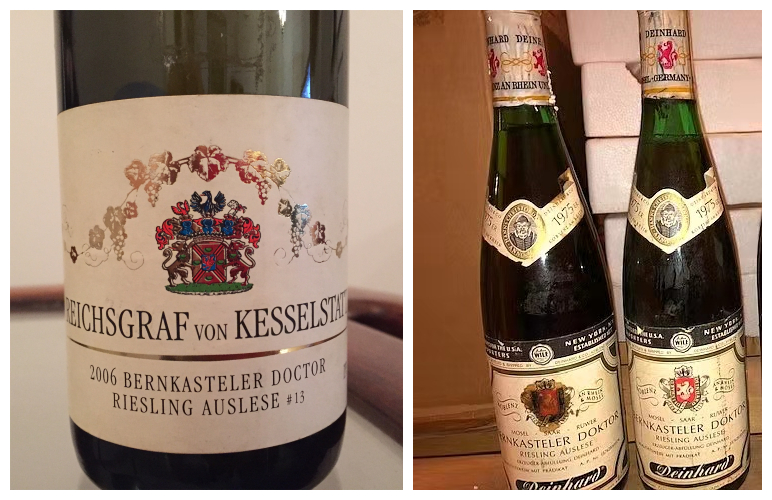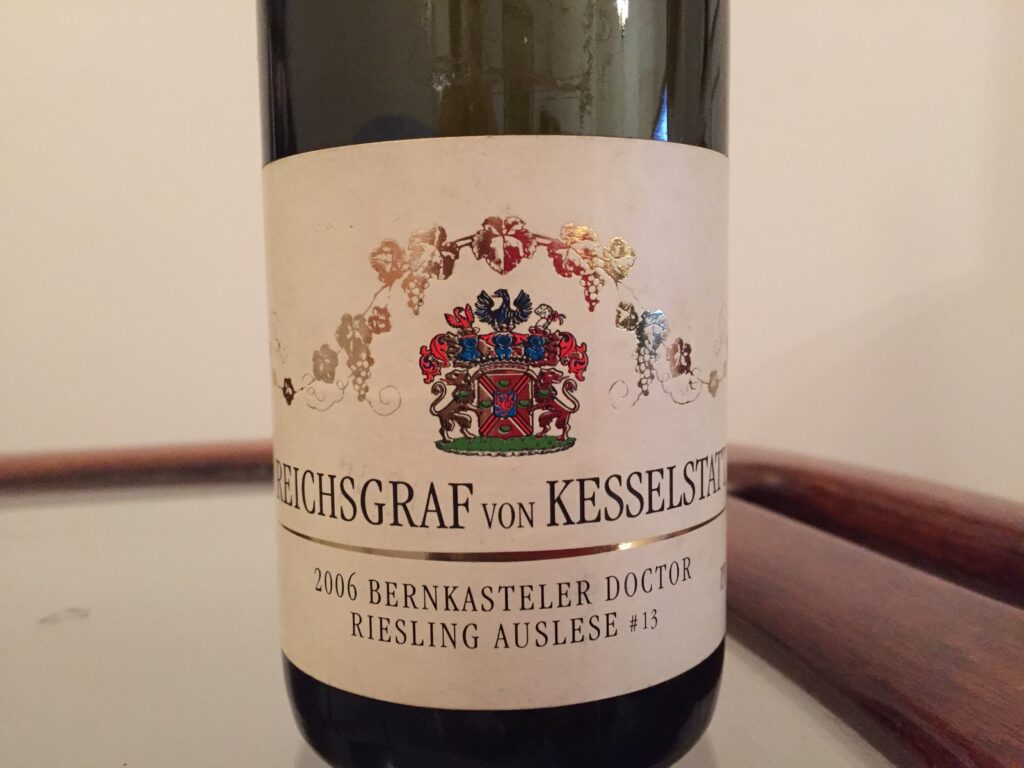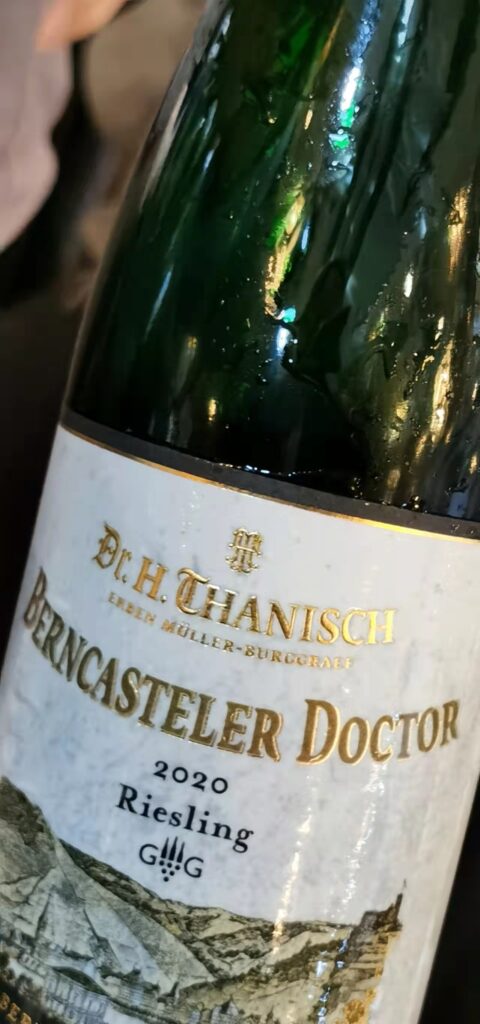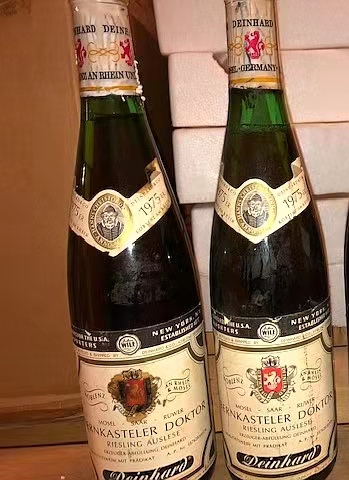Simply put, the Bernkasteler Doctor (also spelled Berkasteler Doktor and Berncasteler Doctor) is one of the world’s five or so most famous vineyards, and also one of its most expensive. Entirely planted to Riesling, it is an extremely steep site (45-60% gradient depending on where you find yourself standing in it) located immediately above the very pretty town of Bernkastel-Kues (Bernkastel and Kues, that are located more or less in front of each other but on opposite sides of the Mosel river, united in 1905 to become Bernkastel-Kues), in the just as pretty Middle Mosel. Indeed, while you strain your neck looking above the rooftops of the homes in the center of Bernkastel, you cannot avoid feeling like the vines above the rooftops are going to slide down into someone’s living room or bedroom at any time. The vineyard is only 3.25 hectares large, fully south-southwest facing, and characterized by the region’s typical Devonian blue slate, but with good stony-loamy-clay presence (which means that, somewhat uniquely, the Doctor is blessed with both very good drainage and water-retentive capacities). Add to all of that the average age of the wines hovers at around 60 years of age (with vines of 100 years or more not uncommon) and that it is estimated that anywhere from 30-40% are ungrafted, and one understands why the Doctor has been the source of some of the most sought-after German wines of all. The Doctor’s wines are at once rich, profound and even spicy (it’s a rather warm site where the snow melts before than in the surrounding vineyards), but at the same time refined and finely structured, a magic combination that is not so common in the wines from other, even famous, German vineyards. In fact, to Germany’s credit, and to the credit of their wines the country has always placed commendable attention to vineyard quality and wine vineyard provenance, made very clear on the label. Therefore not just Bernkastel, but many other German towns in the country’s wine regions boast fantastic and very famous vineyards, such as for example the Saar’s Scharzhofberger (most famous thanks to Egon Muller’s truly amazingly great wines), Wehlen’s and Zelting’s Sonnenuhr sites in the Mosel, the Schlossböckelheimer Kupfergrube and the Oberhauser Bruke of the Nahe, the many fine Niersteiner sites of the Rheinhessen, the Kirchenstück and Jesuitengarten vineyards of Forst in the Pfalz (along with the Doctor, two of the most expensive pieces of vineyard land anywhere), the Saar’s Scharzhofberger, the Ruwer’s Abstberg, the Juklius-Echter-Berg of Iphofen in the Franken, the Erbacher Marcobrunn, Hattenheim’s Steinberger (parts of it, at least) as well as its Wisselbrunnen and Nussbrunnen sites, and the Rudesheim sites in the Rheingau, but there are many, many, more still and there really isn’t enough room here to list them all without doing them an injustice. But of them all, historically at least, the Doctor is arguably the most famous.

A little bit of history
To begin with, why does the vineyard carry such a curious and unique name? That is not clear. Legend has it that the wine of the Doctorberg healed Archbishop Boemund II, the Trier Elector, of a serious illness during a stay at Landshut Castle when everything else had failed. Upon his recovery, he apparently voiced the opinion that the vineyard deserved a doctor’s degree; and so, not surprisingly, the vineyard became known as “the doctor” in perpetuity. Listen now: as far as legends go, it’s a pretty good one, so we might as well stick with it (and in fairness, it has been reported that King Edward VII of Great Britain drank the wine from the vineyard as “medicine” as well; at the very least, it sure tasted better than cod liver oil or other medicinal remedies he might have been otherwise given). In any case, it has been reported that the vineyard’s name as such first appears in the 1636 registers of Bernkastel, and again in a 1677 inheritance document of the clergyman Heinrich Lindent, so awareness of the site as such has been high for centuries.
No matter the owners, the wine has seemingly enjoyed a glorious reputation throughout the ages as well, though by all accounts that reputation seems to have really crystallized as of the beginning of the twentieth century (for example, in his 1821 volume on the curative qualities of Mosel wine, Karl Graff reportedly wrote that the wines of Bernkastel did not have any outstanding characteristics. Apparently, other prominent nineteenth century wine writers such as Cyrus Redding and Johann Philipp Bronner seemed unaware, or were unimpressed, by the Doctor vineyard and its wines; though clearly, that lack of awareness could be on them, and not because of any fault of the vineyard and its wines). But all this changed with Julius Wegeler’s (co-owner of the famous and large Deinhard wine firm) acquisition of a 43 ares plot of land (roughly 0.4 hectares) on the Doctorberg for 100 gold marks per vine (including the wines in the cellar), which made it at the time and for more than 100 years following (at least until 2012) the highest price ever paid for vineyard land in Germany. To help you put that monetary amount in perspective, keep in mind that 100 Reichsmarks is the modern-day equivalent of roughly Euros 2000 (I have seen estimates ranging between Euros 1,000-4,000 of today’s money. As at the time vineyards were planted at extremely high density (at roughly 10,000 vines per hectare) this means that Wegeler paid, in 1900, about Euros 20 Million per hectare (ranging anywhere from Euro 10-40 million per hectare) in today’s coin. Incredible, really. And so it shouldn’t surprise anyone then that the wines from such a hallowed site have long been some of the most expensive of all, and that they have always boasted a “who’s who” of fans. Besides King Edward VII, the list includes General Dwight D. Eisenhower, Kaiser Wilhelm II, and Konrad Adenauer. Relative to Adenauer, in September 11, 1955, bottles of the 1950s Bernkasteler Doctor Spätlese (that had been specifically brought over from Germany) were opened at the diplomatic lunch in Moscow and also given as gifts to Bulganin, Khrushchev and Molotov. Until very recently, the wines of the Dr. Thanish estate (arguably the most famous owner of the Bernkasteler Doctor), sold for more money than the best wines from Bordeaux and Burgundy [for example, old catalogues of 1960s wine stores show the Dr. Thanisch Auslese wines all sold for more than the likes of Château Lafite, Château Latour, Chambertin (Damoy), Grands Echezeaux (Gros) and other vaunted names in French wine)].
It follows that owning a piece of the Doctor vineyard was a matter of paramount importance, and over the years, those fortunate enough to own land there fought many a battle to defend their holdings as well as both the original size and reputation of the vineyard. Human nature being what it is (and the fact that green is the favourite colour of many people) fatefully means that anything and anyone famous enough to attract wealth will also attract its share of fraudsters and imitators. And so it was that a bunch of Doctor-inspired names began appearing on other German wines of dubious quality and uncertain pedigree. And as is often the case even in modern times, not all courts see things the same way. Relative to the Doctor sturm und drang, some Chambers of Commerce apparently tried to make the Doctor brand name available for any wine of “comparable quality,” but the Chambers of Trier and Koblenz objected, and were finally successful in preventing growers outside of Bernkastel from using the Doctor name.
The Doctor appears to have been originally owned by Count von der Leyen, but when in 1794 the French Revolutionary Army invaded the Trier area (where Bernkastel is located) it declared it under French rule; the Berncasteler Doctor was declared community property and its ownership changed. The Thanisch family (involved in wine since 1636), was able to at lease and later buy vines in the Doctor, such that a majority of the vineyard became the property of Dr. Hugo Thanisch and his wife Katharina. This is important, for it is this family’s members that are mostly responsible for greatly increasing and maintaining the fame of both site and wines over the years. The original Dr. Thanisch unfortunately died in 1895 when he was only forty-one years of age, with the estate then managed by his twenty-nine years old widow; in Veuve Clicquot-like fashion, the estate was named after the widow or Wwe. Dr. H. Thanisch (where “widow” in German is witwe, abbreviated as “wwe.”). In fact, it was Katharina who introduced in 1901 the Art Nouveau-styled label that the estate’s bottles are famous for. It is noteworthy that even after Katharina, other women have played important roles in managing this storied vineyard and wine estate, with something like five generations of women at the helm). In the 1990s, due to inheritance laws (and rumoured divergent views between family members on how to best manage the business), the Thanisch property was divided in two equal parts between sisters, and so two very similarly named estates were born: Wwe. H.Thanisch – Erben Thanisch (owned by Sophia Thanisch-Spier, who inherited it in 1996 from her aunt, Mechthild Thanisch, and who runs the estate with her two daughters), and Wwe. H.Thanisch – Erben Müller-Burggraef (owned by Barbara Rundquist-Müller, and managed since 2008 by Maximilian F.W. Ferger), where the German word “erben” essentially means “heirs”). Caveat emptor, the two estates have not just similar names, but also very similar bottle labels, potentially engendering some confusion when picking exactly the Thanisch wine you want. Notwithstanding the different viticultural practices and winemaking methods employed, the two estates own vines in different parts of the Doctor, and logic will tell you that that fact alone cannot but help but fashion different wines even if everything else was kept exactly the same (for example, Wwe. H.Thanisch – Erben Müller-Burggraef’s portion of Doctor vineyards are situated a little higher up from the river, beginning more or less at the middle of the vineyard and continuing upslope to the forest).
The Doctor today
Though Thanisch has long been the main name in the Doctor’s circles, the vineyard also has a few other owners: the Privy Councilor J. Wegeler (about 1.1 hectares), Patrick Lauerburg (two plots). In the past, von Kesselstatt had made a wine from Doctor as well, one of which I have reviewed for this article (the Reichsgraf von Kesselstatt winery leased 0.06 hectares from Wegeler until the end of 2014). Beginning with 2016, a further 0.26 hectares owned by the Heilig-Geist-Stiftung (a charitable institution blessed with plots in some choice Bernkastel vineyards), was leased to the Schloss Lieser and Markus Molitor wineries for nine years. Thi si not without interest. I have seen and tasted over the years numerous bottles of 1970’s Bernkastel Doktor wines at various Predikat levels made by yet a different estate than those mentioned above: Freiherr von Schorlemer. It was Clemens Freiherr von Schorlemer-Lieser that married Maria, the daughter of oil magnate Eduard Puricelli who in 1875 had built one of the most majestically beautiful buildings of the Mosel, an 1875 Neo-Renaissance castle known today as Schloss Lieser. The once famous winery fell onto hard times in the 1970s; in 1992, Thomas Haag (eldest son of Fritz Haag) and his wife Ute took up the positions there of Head Winemaker and Director, and then bought the property in 1997, proceeding to make its wines famous once again. That Schloss Lieser is now able to make wines from the Doctor site once again after Freiherr von Schorlemer having done so years before before is just one of the many examples of how everything in life ultimately moves in circles.
In fact, not just the number of the Doctor’s owners have increased over time, but its size too. And even though it is still a very small site (only 3.2 hectares large), it is larger than it once used to be. This is because of the 1971 German Wine Law, when the Bernkasteler Doctor’s boundaries (as well as those of other famed German sites too, such as for example Trittenheim’s famous and also medically-named Apotheke vineyard) were enlarged. No fools, the Doctor’s owners objected (as they should have and had every right to do) and it was not until 1984 that the matter was settled thanks to court proceedings. The fight did bring some measure of success, given the vineyard boundary was enlarged only westwards, taking in a piece of the adjacent Bernkasteler Graben vineyard, but not eastwards (that portion of vineyard land was named Alte Badstube am Doctorberg; keep in mind that the actual Doctor vineyard’s full name is “Doctor am Doctorberg”).
The wines
Though some today like to lament that “the Doctor’s wines are no longer what they used to be”, I caution readers and wine lovers in general to take many such statements with a grain of salt. For example, the latest rage in German wine nowadays is to make wines that are as bone-dry as possible (for example, those of the much-hyped Grosses Gewächs category), wines that have also often been kept on the lees for a very long period of time. The end-result of such activities is that the wines are unbalanced, overly-herbal and bitter (though clearly, not always). A little sugar goes a long way in avoiding bitterness and an unpleasant drying mouthfeel, and for the most part, you will find that the Doctor vineyard wines you come across in this day and age are just fine, delicately juicy and with more or less a trace of sweetness depending on the Predikat category you like drink. I’m a big fan of history, and have a medical degree, so you might say that the wines of the Doctor are right up my alley; I am certainly a big fan, but my hunch is you will be too, right after the first sip.
The following wines were tasted between September 2021 and February 2022, sourced either I Germany and brought over to Shanghai where I live or by importers here in China. As soon as Covd allows, I will visit the German wine producing areas to write longer, more in-depth reports as I have for many other of the world’s wine regions in the past. The names of the wines below are spelled as they appear on the labels: note that the Lauerburg wines have had different spellings in the past, with both Bernkastel and Berncaslet appearing on the labels.
Reichstrgraft von Kesselstat 2006 Bernkasteler Doctor Riesling Auslese #13 94+

Pale straw-green with golden tinges. Candied pears, lemon peel and apples with a dusting of fine minerals dominate on the white flower-accented nose. Beautifully balanced, boasting noteworthy clarity as well as sneaky concentration of stone fruit, crushed rock, apricot, lemon verbena, gin and lime flavours. depth and length. Finishes long and very pure, with a building zesty mineral kick. A very delicate and precise Auslese that is admirably light on its feet, not in a ‘goldkap Auslese’ style wine but a true, fresh, well-made Auslese. Now owned by the Reh family, the von Kesselstatt estate is one of Germany’s most famous wineries, founded back in 1349 (so it has been around for more than 650 years). Drinking window: now-2045.
Lauerburg 1976 Berncasteler Doctor Riesling Beerenauslese 94
Golden yellow. Ripe peach, apricot, elderflower, caramel, and brown spice flavors. Then lively texture on the palate with still noticeable sweetness and surprising power to its stone fruit, cinnamon and mineral flavours. Lovely breed and finesse here, with noteworthy persistence, intensity and balance. Dopesn’t leave an impression of having great acidity to fall back on (typical enough of the 1976 vintage) but there’s still plenty of life ahead: I especially love how the overt thickness and weight are contrasted by a fleeting delicacy on the long pure finish. But I would drink this up for maximum enjoyment, why defer gratitude further? Drinking window: now.
Wwe. Dr. H.Thanisch Erben Thanisch 2016 Berncasteler Doctor Riesling Spätlese 93+
Vibrant straw-green. Nectarine, ginger, green apple, and lemon verbena, with perfumed lemon verbena note on the inviting nose. Then rich but lively, with a succulent, creamily-textured palate and similar flavours to the aromas. Closes very juicy and persistently floral, with beautiful translucency to the lingering sweet nuances of minerals and grilled herbs, nicely framed and extended on the palate by a lip-smacking refreshing salinity. Drinking window: now-2035.
Dr. H.Thanisch – Erben Müller-Burggraef 2019 Berncasteler Doctor Riesling Kabinett 93
Luminous straw-green. White-peach, lemongrass, and honeysuckle aromas on the enticing nose. Then light and delicate, with racy acidity enlivening the sweet but fresh orchard fruit flavours and mineral nuances. Closes silky, with hints of slate-induced saltiness and pink grapefruit and guava on the off-dry, very long back end. This one strikes me as an exceptionally good vintage for the Mosel’s wines. Drink: 2025-2035.
Dr.H.Thanisch Erben Muller-Burggraeff 2017 Berncasteler Doctor Riesling Spätlese 93
Vivid straw-green with golden tinges. Apple, yellow plums, starfruit, and pineapple on the rich, deep nose. Then lovely lightness of touch, with pure, refreshing flavours of papaya, orange zest, minerals, and a hint of minty herbs. Rather full-bodied but with an elegant mouthfeel nicely lifted by a mineral, saline edge that is very typical of this vineyard (though this wine also spent a fair number of months on the lees). and the smokiness and saltiness typical of the Doctor. Great with seafood and fish or graved lax. Lots of flavour and only 8.5% alcohol, but at 101.5 g/L and 7.4 g/L total acidity, really quite sweet, though not as sticky sweet as over one hundred grams in residual sugar might suggest. As always, Riesling’s fantastically vibrant, downright pretty acidity keeps this light and lively on its (sweet) feet. Pair it with also slightly sweet foods, say fish and even poultry involving for example a pineapple coulis or mango-papaya chutney and you’ll have a blast. Can be enjoyed right now, but will be even better with a few years under its belt. Drinking window: 2025-2037.
Dr. H.Thanisch Erben Müller-Burggraef 2020 Berncasteler Doctor Riesling GG 92+

Vivid straw-green. Musk melon, apricot, persimmon, and tangerine aromas are complemented by a touch of honey and lemon custard cream. Then more hints of cream in the mouth, but very light and wafting with wonderful inner-mouth perfume to the peach and pineapple flavours. Medium-bodied and off-dry, this closes with plenty of energy and focus, not to mention long. Drinking window: 2024-2035.
Lauerburg 1979 Berncasteler Doctor Riesling Beerenauslese 91
Brinze yellow colour. Thick, dense aromas and flavours of custard cream, maple syrup, caramel apple, candy floss and quince paste. Thick and luscious but a little low on acidity today, with a nicely ripe, broad and still sweet finish. This is still very enjoyable but was at its best about ten-fifteen years ago: I bough these bottles when I visited Bernkastel in 2000 when Lauerburg was still operating a wine shop in the main strip of the pretty town’s center and bought cases of this and other of the estate’s wines, proceeding to really enjoy them for most of the first decade of the twenty-first century. Today my last remaining bottles are a testament to halcyon days of youth and their memories, but are best drink up, with good friends, as they’ll be more than happy and grateful to sip on history. Drinking window: now.
Dr. H.Thanisch Erben Müller-Burggraef 2016 Berncasteler Doctor Riesling Kabinett 91
Bright straw yellow-green. Pear cider and yellow apple aromas with hints of mint and tropical fruit on the fresh but slightly reticent nose. Enters ripe and sweet, then a little diffuse in the middle, but very refreshing in its glossy texture and delicate nuances of orchard fruit, sweet spices and herbs. Finishes long firm and delicate, with no extra sweetness or baby fat. Drining window: now-2030.
Deinhard 1975 Bernkasteler Doktor Riesling Auslese 89

Deep burnished yellow-gold colour. Beeswax and petrol interplay with caramel apple, guava and pear nectar. Then similar flavours nicely carried by just enough acidity to keep this from being flat, finishing with repeating waxy nuances and rather dryish, saline spice flavours. Lovely wine that is just a little short, though I like its intensity and precision. This was a surprisingly on the dryish side for an Auslese already when I tasted it for the first time back in 1993 or 1994, and clearly, it hasn’t gotten any sweeter since then. Never the longest wine, it still finishes somewhat abruptly today. Drinking window: now.

 中文
中文



